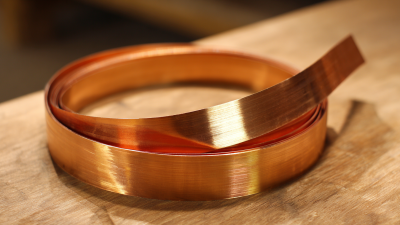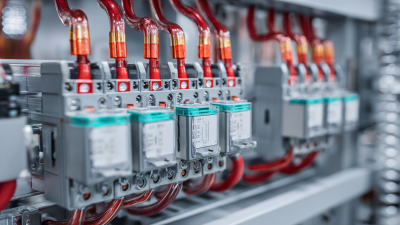Understanding the Benefits of Epoxy Glass Fiber Parts for Sustainable Manufacturing
Table of Contents
- Advantages of Epoxy Glass Fiber Parts in Sustainable Manufacturing
- Performance Properties of Epoxy Glass Fiber in Diverse Applications
- Comparative Analysis: Epoxy Glass Fiber vs. Traditional Materials
- Environmental Impact Assessment of Epoxy Glass Fiber Production
- Cost-Effectiveness of Epoxy Glass Fiber Parts in Manufacturing Processes
- Future Trends: Innovations in Epoxy Glass Fiber Technologies for Sustainability
- FAQS
- Conclusion
- Related Posts
When it comes to sustainable manufacturing these days, using innovative materials like Epoxy Glass Fiber Parts is really becoming a big deal. I came across a report from Grand View Research that says the global market for composite materials is expected to hit around USD 139.83 billion by 2027. That's pretty huge! A big reason for this growth is epoxy resins, which are prized for being both durable and lightweight. Incorporating Epoxy Glass Fiber Parts isn’t just about boosting product performance — it’s also a smart move environmentally. They help companies cut down their carbon footprint, which is pretty awesome.
Industry experts keep highlighting how important these materials are in today’s manufacturing world. Dr. Amelia Carter, who’s well-known in the field of composite materials, mentions, “The versatility and strength of Epoxy Glass Fiber Parts are really transforming how we do things, making manufacturing more sustainable and efficient.” Take Sichuan D&F Electric Co., Ltd., for example. They’ve been around since 2005 and are all about using these advanced materials in their electrical connectors and insulation parts. By choosing Epoxy Glass Fiber Parts, they’re not just improving the quality and dependability of their products — they’re also doing their part for a greener future in the electrical industry.

Advantages of Epoxy Glass Fiber Parts in Sustainable Manufacturing
You know, epoxy glass fiber parts are really gaining popularity these days, especially when it comes to making things more sustainable in the aerospace and automotive worlds. They’re pretty awesome because they manage to be both super strong and lightweight at the same time. That’s a big deal because it helps save energy over the whole life of a product. Take airplanes, for instance—using composite materials has actually helped reduce their weight, which means they burn less fuel and produce fewer emissions. Some studies even suggest that, during operation, these lightweight composites can cut down energy use by up to 30%. That’s a pretty big environmental win, don’t you think?

And it doesn’t stop there. The latest breakthroughs in CFRPs—carbon fiber reinforced polymers—are opening up new doors for eco-friendly manufacturing practices. Researchers are coming up with cool new methods to recycle epoxy and glass fiber composites, which could turn what would be waste into valuable raw materials. Incorporating sustainable materials into production isn't just good for the planet; it also lines up with the whole idea of a circular economy. Plus, reports are saying that using these innovative materials could boost production efficiency and even help lower costs, making sustainable manufacturing not just environmentally smart but economically smart too.
Performance Properties of Epoxy Glass Fiber in Diverse Applications
Epoxy glass fiber composites are pretty impressive when it comes to their performance—no wonder they're used in so many different industries. They’re known for being super strong, handling heat like a champ, and not soaking up moisture easily. All these traits really boost their durability, especially in tough environments. The mix of epoxy resin and glass fibers creates a lightweight but stiff material, making it perfect for things like aerospace, cars, and construction projects where saving weight without losing strength is a big deal.
And let's not forget about their resistance to chemicals—these composites can handle exposure to harsh stuff and extreme temperatures without breaking a sweat. That makes them ideal for use in electrical parts, industrial gear, and even marine applications where reliability is everything. Plus, they’re pretty versatile when it comes to molding techniques, allowing for intricate designs tailored to specific needs. All in all, these features help push forward innovative and sustainable manufacturing practices.
| Property | Value | Application |
|---|---|---|
| Tensile Strength | 350 MPa | Aerospace Components |
| Flexural Modulus | 18 GPa | Automotive Parts |
| Impact Resistance | 5.0 kJ/m² | Sporting Goods |
| Thermal Stability | Up to 150°C | Electronics |
| Chemical Resistance | Excellent | Marine Applications |
| Density | 1.9 g/cm³ | Construction |
Comparative Analysis: Epoxy Glass Fiber vs. Traditional Materials
When you compare epoxy glass fiber parts to more traditional materials, the differences are pretty clear — these composites really have some big advantages, especially if you're into sustainable manufacturing. They aren’t just strong and durable; they also work great in applications where toughness matters the most. Recent research on fiber-reinforced polymers shows that not only do these materials boost the structural integrity, but they also help cut down on environmental impact. For example, life cycle assessments often find that using glass fiber-reinforced polymers means less resource use and waste compared to the old-school materials we're used to.
Plus, when folks look into the mechanical properties of these composites, they find that epoxy glass fiber parts tend to last a really long time. Unlike traditional options that can be heavier and less eco-friendly, these epoxy composites are lightweight but still super strong. They hold up well even under repeated stress — impact tests, for instance, show they’re pretty resilient. All of this makes them a no-brainer for various engineering projects today. As industries shift toward greener, more sustainable practices, including epoxy glass fiber parts just makes sense — it lines right up with those eco-friendly goals we’re all aiming for.
Environmental Impact Assessment of Epoxy Glass Fiber Production
When you really look into the environmental impact of making epoxy glass fibers, it’s a mixed bag of challenges and opportunities. These fibers are pretty amazing — super durable and strong — which is why they’re used all over different industries. But, on the flip side, their production can cause some real environmental headaches, especially with emissions of volatile organic compounds (VOCs) and the waste that's left behind. Knowing all this stuff is super important for manufacturers who want to cut down their ecological footprint and be a bit greener.

Luckily, folks are coming up with creative ideas to make the process more sustainable. Things like switching to bio-based resins instead of relying heavily on petroleum can make a big difference. Plus, there are new recycling methods that aim to reclaim fibers from old products, giving them a second life.
Using tools like life cycle assessments (LCAs) helps companies see exactly where their processes are causing the most environmental impact, so they can target those hot spots and improve. Not only does this help lower emissions, but it also pushes us toward a circular economy — where materials are reused and repurposed instead of just thrown away. All of this ultimately benefits both the environment and the manufacturers trying to do better.
Cost-Effectiveness of Epoxy Glass Fiber Parts in Manufacturing Processes
You know, epoxy glass fiber parts are really making waves as a smart, budget-friendly option in the world of sustainable manufacturing. I came across a report from the 2022 Composite Materials Association that says using reinforced composites can cut manufacturing costs by up to 20% when compared to the usual materials. The big reason? Well, these parts are lightweight, which means production and transportation are way more efficient — saving time and money. Plus, they’re super durable and resistant to corrosion, which means they last longer and you don’t have to replace them as often. That kind of longevity really adds up in terms of savings over the long run.
On top of that, a recent study published in the International Journal of Advanced Manufacturing Technology shows that switching to epoxy glass fiber composites can cut down energy use during manufacturing by as much as 15%. That’s pretty cool, especially since it lines up perfectly with sustainability goals and helps lower operational costs. As industries look for smarter ways to streamline their production without hurting the environment, using these composites seems like a no-brainer — it checks all the boxes for being budget-friendly and eco-conscious at the same time.
Future Trends: Innovations in Epoxy Glass Fiber Technologies for Sustainability
The future of sustainable manufacturing is really starting to hinge on new advancements in epoxy glass fiber tech. I came across a report from MarketsandMarkets that estimates the global epoxy resin market could hit around $10.4 billion by 2025. That’s mainly because industries everywhere are looking for lighter, tougher materials. These epoxy glass fiber composites aren’t just about being strong—they actually boost the durability and lifespan of products, which is a big win for cutting down waste and supporting a circular economy, you know?
Lately, there’s been some cool progress in how these resins are made and cured. For instance, the American Composites Manufacturers Association highlighted the rise of bio-based epoxy resins. Apparently, switching to these can cut down carbon emissions by as much as 30% compared to the old petroleum-based stuff. Plus, new manufacturing methods like automated fiber placement and even 3D printing are making it easier and faster to produce these parts while using less resources and energy overall. All these trends together really paint a hopeful picture for how manufacturing can become more sustainable in the coming years.
Understanding the Benefits of Epoxy Glass Fiber Parts for Sustainable Manufacturing
FAQS
: Epoxy glass fiber composites are known for their excellent mechanical strength, superior thermal resistance, low moisture absorption, and chemical resistance, making them durable and reliable in a variety of challenging environments.
These composites are commonly used in aerospace, automotive, and construction applications, where weight reduction without compromising strength is crucial.
Epoxy glass fiber composites offer superior mechanical properties and reduce resource consumption and waste production, making them a sustainable alternative to traditional materials.
Epoxy glass fiber parts can reduce manufacturing costs by up to 20%, improve production efficiency, and decrease energy consumption by as much as 15% compared to traditional materials.
They provide a lightweight yet strong alternative to conventional materials and demonstrate resilience against repeated mechanical stress, leading to long-lasting performance.
Their adaptability to various molding techniques allows for the production of intricate designs that meet specific operational requirements, driving innovation in sustainable manufacturing practices.
Their superior durability and corrosion resistance extend their lifecycle and reduce the frequency of replacements, contributing to long-term savings in manufacturing.
Their lightweight properties improve transportation efficiency, which is a significant factor in reducing overall manufacturing costs.
Yes, their integration leads to lower operational costs and aligns with sustainability goals, contributing to a reduced environmental footprint.
Their performance characteristics allow for versatility in design and application, making them suitable for use in electrical components, industrial equipment, and marine applications under harsh conditions.
Conclusion
You know, epoxy glass fiber parts are really starting to make a big splash in the world of sustainable manufacturing. They come with a ton of great benefits, and honestly, they're pretty impressive when it comes to performance. You'll find them used in all sorts of things — from insulating electrical stuff to building structural parts. When you compare them to traditional materials, they just seem to hold up better — more durable, more efficient. Plus, making these parts doesn’t seem to hurt the environment as much as other options, which is a big win given the push for sustainability worldwide.
Here at Sichuan D&F Electric Co., Ltd., they’re really in a good spot to take advantage of these new epoxy glass fiber technologies. They’re not just about cutting costs; they’re also pushing for innovation, and that combo could really push the industry forward. As these materials keep evolving, I get the feeling they’ll help producers become more environmentally friendly while also saving some money — a win-win, really.
Related Posts
-

The Ultimate Checklist to Choosing the Best Copper Bus Bar for Global Procurement
-

How to Choose the Right Flexible Copper Strip for Optimal Electrical Performance
-

How to Optimize Your Production Process with Gpo-3 Plastic for Efficiency and Sustainability
-

How to Achieve Maximum Energy Efficiency with H Class Insulation Solutions
-

How to Choose the Right Flexible Busbar Solutions for Your Industrial Needs
-

How to Choose the Best Tin Plated Copper Bus Bar for Your Electrical Needs









